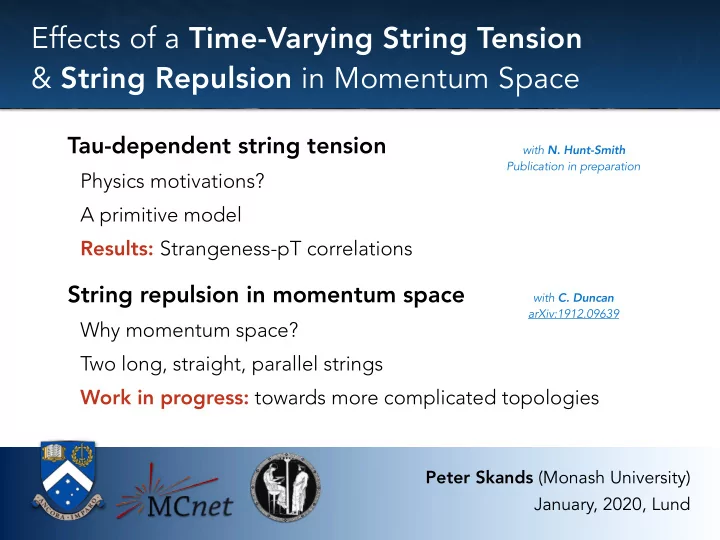

Effects of a Time-Varying String Tension & String Repulsion in Momentum Space Tau-dependent string tension with N. Hunt-Smith Publication in preparation Physics motivations? A primitive model Results: Strangeness-pT correlations String repulsion in momentum space with C. Duncan arXiv:1912.09639 Why momentum space? Two long, straight, parallel strings Work in progress: towards more complicated topologies Peter Skands (Monash University) January, 2020, Lund
<latexit sha1_base64="JqW1qZV98otmV2k0JL7xjy7ACs0=">ACBHicdVBNS8NAEN3Ur1q/oh57WSyCBwlJrVpvRS8eK9hWaELZbDft0t0k7G6Enrw4l/x4kERr/4Ib/4bN2kEFX0w8Hhvhpl5fsyoVLb9YZQWFpeWV8qrlbX1jc0tc3unK6NEYNLBEYvEjY8kYTQkHUVIzexIj7jPT8yUXm926JkDQKr9U0Jh5Ho5AGFCOlpYFZFdAdKe1zaFt19xC6HKmx4GnAZwOzZlvHtnN2YmvTzpGTpnPkQKdQaqBAe2C+u8MIJ5yECjMkZd+xY+WlSCiKGZlV3ESGOEJGpG+piHiRHp/sQM7mtlCINI6AoVzNXvEyniUk65rzuzE+VvLxP/8vqJCpeSsM4USTE80VBwqCKYJYIHFJBsGJTRAWVN8K8RgJhJXOraJD+PoU/k+6dctpWI2rRq1XsRBlWwBw6A05BC1yCNugADO7A3gCz8a98Wi8GK/z1pJRzOyCHzDePgGN65du</latexit> <latexit sha1_base64="HK6rTLiZ/EWGiv3Y9JXQACyvjo=">AC3icbVDLSgNBEJyNrxhfqx69DAlCRAy7EtCLEPTiMYJ5QBJC72Q2GTI7u8zMCmHZnL34K148KOLVH/Dm3zh5HDSxoKGo6qa7y4s4U9pxvq3Myura+kZ2M7e1vbO7Z+8f1FUYS0JrJOShbHqgKGeC1jTnDYjSHwOG14w5uJ3igUrFQ3OtRDsB9AXzGQFtpK6drxflCR5fjfFZ25dAEkgTmeLx6Ri3hxBFgGXLjglZwq8TNw5KaA5ql37q90LSRxQoQkHpVquE+lOAlIzwma8eKRkCG0KctQwUEVHWS6S8pPjZKD/uhNCU0nq/JxIlBoFnukMQA/UojcR/NasfYvOwkTUaypILNFfsyxDvEkGNxjkhLNR4YAkczciskATCTaxJczIbiLy+T+nJLZfKd+VC5XoeRxYdoTwqIhdoAq6RVUQwQ9omf0it6sJ+vFerc+Zq0Zaz5ziP7A+vwBKI2Z4g=</latexit> Tension and the Lund String Model ๏ Cornell potential • Potential V(r) between static (lattice) and/or steady-state (hadron spectroscopy) colour-anticolour charges: − a V ( r ) = r + κ r String part Coulomb part Dominates for r & 0 . 2 fm • Lund model built on the asymptotic large- r linear behaviour ๏ But intrinsically only a statement about the late-time / long- distance / steady-state situation. Deviations at early times? • Coulomb effects in the grey area between shower and hadronization? Low- r slope > κ favours “early” production of quark-antiquark pairs? • + Pre-steady-state effects from a (rapidly) expanding string? � 2 P E T ER S K A ND S
<latexit sha1_base64="3BhDq5dkSG8conVHSg0oex4ox0=">AB+XicdVDLSsNAFJ34rPUVdelmsAiuYqJV60YKblxW6AuaUCbTSTt0MhlmJoUS+iduXCji1j9x5984TSOo6IELh3Pu5d57QsGo0q7YS0tr6yurZc2yptb2zu79t5+WyWpxKSFE5bIbogUYZSTlqaka6QBMUhI51wfDv3OxMiFU14U08FCWI05DSiGkj9W27CX0hE6ET6J36GqV9u+I6F653felC13Fz5KTmnXvQK5QKNDo2+/+IMFpTLjGDCnV81yhgwxJTEjs7KfKiIQHqMh6RnKUxUkOWXz+CxUQYwSqQprmGufp/IUKzUNA5NZ4z0SP325uJfXi/VUS3IKBepJhwvFkUpg+bPeQxwQCXBmk0NQVhScyvEIyQR1iasgnh61P4P2mfOV7Vqd5XK/WbIo4SOARH4AR4ArUwR1ogBbAYAIewBN4tjLr0XqxXhetS1YxcwB+wHr7BKwukwo=</latexit> Pre-Equilibrium Effects? ๏ In a recent paper (JHEP 04(2018)145), Berges, Floerchinger, and Venugopalan developed a framework for • “computing the entanglement between spatial regions for Gaussian states in quantum field theory” ๏ which they • “… applied to explore an expanding light cone geometry in the […] Schwinger model for QED in 1+1 space-time dimensions. “ • ➤ Entanglement entropy is extensive in rapidity at early times • ➤ “a thermal density matrix for excitations around a coherent field with a time dependent temperature ”: T ∝ 1 / τ ๏ What does this mean in Lund Model context? � 3 P E T ER S K A ND S
<latexit sha1_base64="3BhDq5dkSG8conVHSg0oex4ox0=">AB+XicdVDLSsNAFJ34rPUVdelmsAiuYqJV60YKblxW6AuaUCbTSTt0MhlmJoUS+iduXCji1j9x5984TSOo6IELh3Pu5d57QsGo0q7YS0tr6yurZc2yptb2zu79t5+WyWpxKSFE5bIbogUYZSTlqaka6QBMUhI51wfDv3OxMiFU14U08FCWI05DSiGkj9W27CX0hE6ET6J36GqV9u+I6F653felC13Fz5KTmnXvQK5QKNDo2+/+IMFpTLjGDCnV81yhgwxJTEjs7KfKiIQHqMh6RnKUxUkOWXz+CxUQYwSqQprmGufp/IUKzUNA5NZ4z0SP325uJfXi/VUS3IKBepJhwvFkUpg+bPeQxwQCXBmk0NQVhScyvEIyQR1iasgnh61P4P2mfOV7Vqd5XK/WbIo4SOARH4AR4ArUwR1ogBbAYAIewBN4tjLr0XqxXhetS1YxcwB+wHr7BKwukwo=</latexit> Implications for Lund Model? ๏ I asked an honours student (N. Hunt-Smith) to take our 4 th year quantum information course to see if we could parse the entanglement arguments • He learned a lot but we still didn’t have a dictionary ๏ We imagine it means the steady state captured by the lattice gets to have thermal excitations characterised by T ∝ 1 / τ • But what does that mean? ๏ Additional (virtual) quark-antiquark pairs with thermal distribution, which decay away with time? • Allow some of these to become real ➤ new mechanism for string breaks? • First step poor man’s model : to explore effects of a higher effective energy scale and/or steeper potential well being relevant at early times. � 4 P E T ER S K A ND S
<latexit sha1_base64="mjNCfjTfO43HIxrXkNGUlAHruog=">ACJHicdVBaxNBGJ2tWtNoa9Sjl8EgtBTS2Ro1IkhBDx4rmLaQDcu3ky/JkJndYeZbISz5MV78K148qMWDF3+Ls9sUqtQHwze+z5m3susVp6E+BVt3Lh5a/N2a6t95+72zr3O/QcnvidxKEsdOHOMvCoVY5DUqTxzDoEk2k8zRZvav/0IzqvivwDLS2ODcxyNVUSKEhp51XyFjVBsgBrIU0M0NyZiubozGo3ISj3eGJdYang8UEj8H1eX6nYSztd0Xsm4pfPBRc90aAhg/hpzO10mVrHKedH8mkKXBnKQG70exsDSuwJGSGlftpPRoQS5ghqNAczDox1UTcsWfBGXCp4ULJyfeqFc3KjDeL0WJusU/l+vFq/zRiVNB+NK5bYkzOXFQ9NS8xC5boxPlENJehkISKfCX7mcgwNJod2KOEyKf8/OTnsxf1e/32/e/R6XUeLPWKP2S6L2Qt2xN6xYzZkn1iX9g39j36H2NzqOfF6Mb0XrnIfsL0e8/A3WkVw=</latexit> <latexit sha1_base64="Kh5SYRXNhbg9tajfJiRiviyG0+g=">ACMXicdVBdSxtBFJ21rdX40aiPvgwNglIszb140EJ1Ic8WmhUyIZwd3LXDJnZXWbuCmHJX+qL/6T0xQel9LV/wkncQiv2wMDhnHOZe0+ca+VIiLtg4dXrN4tvl5ZrK6tr6+/qG5sXLiusxK7MdGavYnCoVYpdUqTxKrcIJtZ4GY8/z/zLG7ROZelXmuTYN3CdqkRJIC8N6p1oDHkOg8gAjawpMUmuxFBscdPeOUJ/oFHZ6gJnoVphNZU8UG9IZqfRHh8ILhoijnm5Cj8GPKwUhqswvmg/j0aZrIwmJLU4FwvFDn1S7CkpMZpLSoc5iDHcI09T1Mw6Prl/OIp3/HKkCeZ9S8lPlf/nijBODcxsU/OdnXPvZn4ktcrKDnqlyrNC8JUPn2UFJpTxmf18aGyKElPAFpld+VyxFYkORLrvkS/lzK/08u9pthq9n60mq0T6s6ltg2e892WcgOWZt12DnrMsm+sR/snj0Et8Fd8DP49RdCKqZLfYPgt+PVXeqTw=</latexit> <latexit sha1_base64="nynqxQqpLVYTfntAtUYbM1XFQTo=">ACXicdVDLSsNAFJ34rPVdelmsAgupE60at1IwYUuK9gHNCFMpN26EwSZiZCd268VfcuFDErX/gzr9xmkZQ0QMXDufcy73+DFnSiP0Yc3Mzs0vLBaWisrq2vrpY3NloSWiTRDySHR8rylIm5pTjuxpFj4nLb94cXEb9SqVgU3uhRTF2B+yELGMHaSF4JOkMcx9hD0FMQNvZdwTWAynS9o6CMTYK5VR5RjZycIogrKkJGafWRDO1fKIEfDK707vYgkgoacKxU10axdlMsNSOcjotOomiMyRD3adfQEAuq3DT7ZAx3jdKDQSRNhRpm6veJFAulRsI3nZMz1W9vIv7ldRMd1NyUhXGiaUimi4KEQx3BSywxyQlmo8MwUQycyskAywx0Sa8ognh61P4P2kdVuxqpXpdLdfP8zgKYBvsgD1g1NQB1egAZqAgDvwAJ7As3VvPVov1u0dcbKZ7bAD1hvn2f/mYc=</latexit> Tau-Dependent String Tension ๏ As a minimal modification to the existing string model, we studied the consequences of allowing an effective string tension κ e ff ( τ ) = κ 0 + ∆ κ therm ( τ ) • where and with τ 0 a κ 0 ∼ 1 GeV / fm ∆ κ therm ( τ ) ∝ 1 / ( τ + τ 0 ) regularisation parameter that keeps the effective string tension finite and physically reflects that the string model itself is anyway not appropriate for very early (perturbative) times. ๏ Some Questions: • To model Coulomb effect, study Δ κ ~ d/dr ( -1/r ) = 1/r 2 ? (and does 1/r 2 really map to Δ κ ~ 1/ τ 2 ?) ๏ • To model thermal effect, does T ~ 1/ τ really map to Δ κ ~ 1/ τ ? • (Nuts & bolts not strongly tied to any particular form) 5 � P E T ER S K A ND S
Calculating Tau ๏ To use our modified κ ( τ ), need to know the τ value of each vertex • In UserHooks, we have access to the Γ = κ 2 x + x - = κ 2 τ 2 hyperbolic coordinate (via StringEnd) • Solve for τ but now using a non-linear relationship (with < τ >=1.2 GeV -1 ) ◆ 2 ✓ k < τ > τ 2 Γ = κ 0 + ∆ κ max τ + k < τ > • with Δ κ max and k as free parameters governing the shape of κ ( τ ). • (Solution is rather unattractive though.) s √ √ ! max k 2 < τ > 2 + 2 ∆ κ max k 2 < τ > 2 τ = 1 Γ − k < τ > − ∆ κ max k < τ > 1 Γ − 2 ∆ κ max Γ k < τ > + ∆ κ 2 + κ 2 κ 2 κ 2 2 2 κ 0 κ 0 κ 0 0 0 0 6 � P E T ER S K A ND S
<latexit sha1_base64="2s6XM2N1uLTqxsIu+dLW43Fs/o=">ACN3icbVBNa9tAFylTes4Seskx16WmoIDrSMVQ0MhEJpLT8WBOAlYjnhaP9mLV9Ky+1QwQv+ql/yN3JpLDi2h1/yDrD8O+ejAwjDzHm9nYq2kJd/7a28eLn6nVtrb6+sfnmbWNr+9TmhRHYE7nKzXkMFpXMsEeSFJ5rg5DGCs/iydHMP/uJxso8O6GpxkEKo0wmUgA5KWr86EZlmAKNTVqCEKip+lgMq1ZIUOzyAx4qTKjlhuxXJ4dGjsa0e1EGn8IJaA2Rv7cgi4UqajT9tj8Hf06CJWmyJbpR4yoc5qJIMSOhwNp+4GsalGBICoVPSwsahATGHf0QxStINynrviH5wy5Elu3MuIz9WHGyWk1k7T2E3OItqn3kz8n9cvKNkflDLTBWEmFoeSQnHK+axEPpQGBampIyCMdH/lYgwGBLmq6E4Gnk5+T0czvotDvHnebht2UdNfaOvWctFrAv7JB9Z13WY4L9YtfsD/vrXo3q3bzG64i13dtgjeHf3tbmsZQ=</latexit> UserHooks implementation in Pythia ๏ Want to generate string breaks with modifiable strangeness ratios and p T broadening values. • Problem: no easy way to modify the trial probabilities; doChangeFragPar() appears to require constant reinitialisation (and changes are not re-set after use). • Solution for strangeness enhancement: no change of trial probabilities; implement instead as up/down suppression using doVetoFragmentation(). ๏ Generate trial breakups as usual, using nominal P s:ud • Always accept a strange quark P accept ,ud ( τ ) = ( P s : ud ) 1 − κ 0 / κ ( τ ) • Accept u,d with probability In limit κ ≫ κ 0 : same probability to accept ud as was already generated for s ๏ In limit κ ~ κ 0 : probability to accept ud → 1 ➤ effective P s:ud unchanged ๏ 7 � P E T ER S K A ND S
Recommend
More recommend